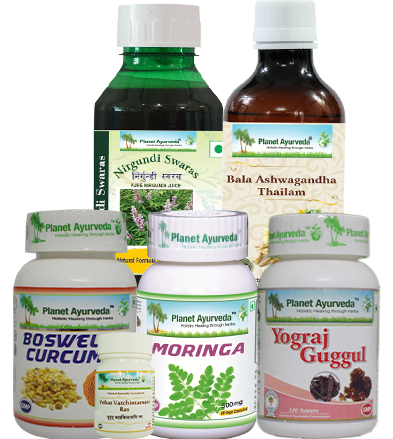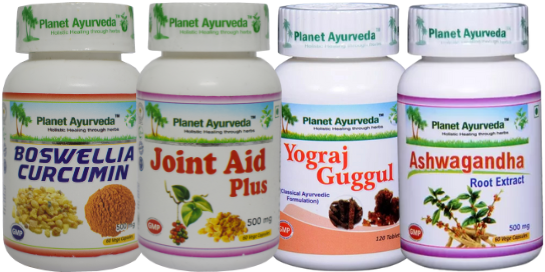What is Myofascial Pain Syndrome?- Causes Symptoms & Ayurvedic Treatment
ABSTRACT
Healthy muscles keep our bodies strong and allow them to move freely. Healthy muscles make us enjoy swimming, playing sports, walking the dog, dancing and various other fun activities. There are a lot of daily activities that one must be able to do properly if their muscles are healthy like vacuuming of carpet, bed making or like cutting the lawn grass. Strong muscles play a great role in keeping a good shape of the joints. If muscles around any area get weak it will definitely make that area or joint more prone to injury. For strong muscles the process of muscle contraction must be regulated and if it gets disturbed the muscle health gets affected too. There are a lot of conditions which disturbs the muscles contraction, one among them is Myofascial Pain Syndrome. About this condition we are going to discuss in this article along with its Ayurvedic management.
INTRODUCTION
Myofascial Pain Syndrome is one of the Chronic Pain disorders that affects muscles as well as fascia. This condition is characterized by pressure on the trigger points of the muscles that cause pain in muscles and sometimes in other body parts which is known as referred pain. The typical cause of this syndrome is repetitive muscle contraction which mainly includes repetitive motions that are due to job or any other hobby and muscle tension related to stress. Everybody experiences muscle pain once in a while in their life but if it continues in the same place for a long time then it must be a myofascial pain. So now further we will discuss this syndrome in detail.

SOME FACTS ABOUT MYOFASCIAL PAIN SYNDROME
Following are some of the facts that one must know about Myofascial Pain Syndrome:
- It affects about 85% of people
- This condition is misdiagnosed with some other conditions such as neck pain, headache, pelvic pain, shoulder pain, etc.
- Women and men are equally affected.
- The most affected areas are sternocleidomastoid muscles, trapezius muscle, levator scapulae, infraspinatus and rhomboids.
CAUSES OF MYOFASCIAL PAIN SYNDROME
Following are the causes of Myofascial Pain Syndrome
- Muscle injury
- Repetitive muscle strain
- Lack of muscle activity
- Poor posture
- Living or working in cold environment
- Pinched nerve
- Emotional stress
- Hormonal problems
- Metabolic problems
- Vitamin deficiencies
- Chronic infections
SYMPTOMS OF MYOFASCIAL PAIN SYNDROME
Symptoms vary from patient to patient in the condition of Myofascial Pain Syndrome. Sometimes the symptoms get aggravated at once which is known as flare up and on other times the pain remains dull or constant. Following symptoms can be experienced by a person with Myofascial Pain Syndrome
- Deep aching tight, throbbing and stiff like discomfort.
- Trigger points develop in the muscles which are small nodule-like formation in the muscles that leads to pain on touch.
- Tenderness in muscles
- Weakness in muscles
- Depleted motion of muscles
Other health issues also coincide with it that are written as follows
- Poor sleep
- Headaches
- Stress
- Anxiety
- Depression
- Fatigue
DIAGNOSIS OF MYOFASCIAL PAIN SYNDROME
As we discussed earlier this condition is misdiagnosed with various other conditions. As some people mistake their problem with various problems such as the problems related to ligaments, bones, nerves or tendons but in actual this condition is associated with muscles. There are no specific tests to be performed for diagnosing this condition. On the other hand there are no specific symptoms which can be examined to diagnose Myofascial Pain Syndrome like swelling, redness or any warmth like symptoms. The healthcare provider advises the best method for diagnosing this condition is regular physical examination of muscles. Especially one must have to notice the bulge or trigger points in the muscles which can cause referred pain.
Four trigger points are there which we have to notice
- One is an active trigger point which locates within muscles and when pressure is applied, it leads to regional or local pain.
- Then is the latent trigger point which is prone to be active but remains dormant.
- The other point is the secondary trigger point, this is located in other muscles not in the same one which grasps the active trigger point.
- The last and the fourth trigger point is satellite trigger point, this point becomes inactive as it gets overlapped by another region of the trigger point.
AYURVEDIC VIEW OF MYOFASCIAL PAIN SYNDROME
Ayurveda is a holistic science which has been working on the aim of maintaining the health of the healthy person and alleviating disease of the diseased person for more than 3000 years. Myofascial Pain Syndrome is a condition that as per Ayurveda is caused by ama dosha accumulation which leads to obstruction in the channels and aggravation of vata dosha which at last leads to pain. The main pathology is mamasavaha sroto dushti which leads to vata dosha aggravation and causes pain as a major symptom.
Sroto Dushti Nidaan: As per Acharya Charaka (Ch Vi. 5/23), Sroto Dushti nidaan are written as – Consuming food having same qualities as that of aggravated dosha, consuming food having qualities that depletes dhatus (bodily tissues), all such type of food items cause toxicity of Srotas (body channels).
Sroto Dushti common symptoms: As per Acharya (Ch.Vi. 5/24), there are four common symptoms of sroto dushti that are ati pravriti (excessive secretion of channels flow), Sang (obstruction), Vimarga gamana (flow of particular channel fluid to some other part), Sira Granthi (Cystic swelling in channels).
Above information is common for all kinds of sroto dushti, in Mamsa Vaha Srotas Dushti in this condition there are symptoms associated with sang (obstruction) in mamsa vaha srotas.
Causes of Mamsavaha Srotodushti
Heavy food intake, intake of food which cause obstruction in channels, sleeping after intake of food, etc.
Symptoms of mamsa vaha srotas dushti
It leads to various disorders associated with muscles.
Treatment of Mamsavaha Sroto Dushti per Ayurvedic texts
According to Ayurveda the line of treatment to be followed is – Agni Karma (para-surgical procedure with the help of heat), Shastra karma (Surgery) or Kshar karma (para-surgical procedure with the help of herbal alkali). In Myofascial Pain Syndrome Agni karma can be used among these three lines of treatments. This procedure assists in removing obstruction from mamsavah srotas and assists in pacifying the vata dosha at that place, helps in relieving pain also. Along with this various herbal remedies are also effective that we are going to discuss below. Let’s have a look!!!!!
HERBAL REMEDIES BY PLANET AYURVEDA FOR MYOFASCIAL PAIN SYNDROME
Planet Ayurveda is a GMP certified company which has been working as per the aim of Ayurveda for more than 10 years. This company formulates 100% Ayurvedic remedies which consist of pure minerals and herbs. These remedies are free from any kind of added preservatives and synthetic materials so these are devoid of any kind of side effects. Remedies are prepared almost with the aim of relieving all kinds of health conditions. For the purpose of alleviating Myofascial Pain Syndrome following remedies are provided by Planet Ayurveda. Let’s take a look at the properties of all herbal remedies and how they are considered as beneficial for the management of Myofascial Pain Syndrome.
- BOSWELLIA CURCUMIN
- YOGRAJ GUGGUL
- MORINGA CAPSULES
- NIRGUNDI SWARAS
- VRIHAT VATCHINTAMANI RAS
- BALA ASHWAGANDHA THAILAM
PRODUCT DESCRIPTION
1. BOSWELLIA CURCUMIN
Boswellia Curcumin is a capsule formulation by Planet Ayurveda. These capsules consist of standardized extracts of herbs Shallaki (Boswellia serrata) and Curcumin (Curcuma longa). Both these herbs have been well known for their analgesic and antiinflammatory properties since ancient times. As this condition is associated with excessive muscle pain so these capsules will help in eliminating that pain effectively.
Dosage: 1 capsule twice daily with plain water after meals
2. YOGRAJ GUGGUL
Yograj guggul is a classical Ayurvedic formulation which is prepared by Planet Ayurveda as mentioned in classical Ayurvedic texts. This is a tablet formulation which consists of ingredients such as guggul (Commiphora mukul), amalaki (Emblica officinalis), pippali (Piper longum) and various others. This remedy has been well known for its vata balancing properties since ancient times. So as this condition is vata predminating so this remedy effectively helps in relieving this condition.
Dosage: 2 tablets twice daily with plain water after meals.
3. MORINGA CAPSULES
Moringa Capsules is a single herbal formulation by Planet Ayurveda which consists of standardized extract of herb sahjan (Moringa oleifera). Moringa herb consists of wonderful antioxidant properties that effectively assist in eliminating free radicals from the body. It has nutritious properties that helps in providing nourishment to the affected muscles and leads to betterment of muscle functions.
Dosage: 1 capsule twice daily with plain water after meals.
4. NIRGUNDI SWARAS
Nirgundi swaras is a liquid formulation made up with juice extract of herb nirgundi (Vitex negundo). This is one of the best vata pacifying herbs as well as reduces ama dosha. By reducing ama dosha it helps in removing obstruction in the muscle channels. The pacification of vata dosha helps in relieving pain. Thus nirgundi swaras is a Beneficial Remedy for Myofascial Pain Syndrome.
Dosage: 2 tsp twice daily with added equal amount of water after
5. VRIHAT VATCHINTAMANI RAS
Vrihat Vatchintamani Ras is a classical ayurvedic formulation which has been used since ancient times for all kinds of vata vyadhi. The formulation is available in tablet form and consists of ingredients such as swarna bhasma (calyx of gold), rajata bhasma (calyx of silver), loha bhasma 9calyx of iron) and various others. These ingredients collectively assist in pacifying vata dosha and reduce symptoms of Myofascial Pain Syndrome. As this condition is also associated with vata dosha aggravation thus this remedy is effective for the same also.
Dosage: 1 tablet once daily to be chewed with warm ghee.
6. BALA ASHWAGANDHA THAILAM
Bala Ashwagandha Thailam is one of the herbal oils formulated by Planet Ayurveda. This oil consists of ingredients such as ashwagandha (Withania somnifera), bala (Sida cordifolia), sesame (Sesamum indicum) and various others. This herbal oil is used for local application. When applied locally by pacifying vata dosha it reduces pain. Also this oil provides nourishment to the affected muscles and improves their functions.
Dosage: Warm the oil and apply locally for 2-3 times a day.
CONCLUSION
Myofascial Pain Syndrome is one of the Chronic Pain disorders that affects muscles as well as fascia. Causes of this condition include Muscle injury, Repetitive muscle strain, Lack of muscle activity, Poor posture, Living or working in a cold environment and various others. Although symptoms vary from person to person, commonly seen symptoms are Tenderness in muscles, Weakness in muscles, Depleted motion of muscles, aching, throbbing pain and stiffness. As per Ayurveda this condition is caused by ama dosha accumulation which leads to obstruction in the channels and aggravation of vata dosha which at last leads to pain. For alleviating this condition various remedies are provided by Planet Ayurveda. If someone is suffering from the same condition then they freely use these remedies without thinking of its side effects as these are 100% pure.






